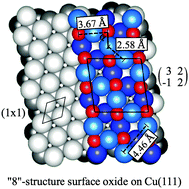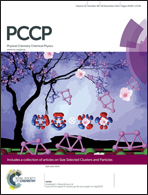Re-visiting the O/Cu(111) system – when metastable surface oxides could become an issue!
Abstract
Surface oxidation processes are crucial for the functionality of Cu-based catalytic systems used for methanol synthesis, partial oxidation of methanol or the water-gas shift reaction. We assess the stability and population of the “8”-structure, a  oxide phase, on the Cu(111) surface. This structure has been observed in X-ray photoelectron spectroscopy and low-energy electron diffraction experiments as a Cu(111) surface reconstruction that can be induced by a hyperthermal oxygen molecular beam. Using density-functional theory calculations in combination with ab initio atomistic thermodynamics and Boltzmann statistical mechanics, we find that the proposed oxide superstructure is indeed metastable and that the population of the “8”-structure is competitive with the known “29” and “44” oxide film structures on Cu(111). We show that the configuration of O and Cu atoms in the first and second layers of the “8”-structure closely resembles the arrangement of atoms in the first two layers of Cu2O(110), where the atoms in the “8”-structure are more constricted. Cu2O(110) has been suggested in the literature as the most active low index facet for reactions such as water splitting under light illumination. If the “8”-structure were to form during a catalytic process, it is therefore likely to be one of the reactive phases.
oxide phase, on the Cu(111) surface. This structure has been observed in X-ray photoelectron spectroscopy and low-energy electron diffraction experiments as a Cu(111) surface reconstruction that can be induced by a hyperthermal oxygen molecular beam. Using density-functional theory calculations in combination with ab initio atomistic thermodynamics and Boltzmann statistical mechanics, we find that the proposed oxide superstructure is indeed metastable and that the population of the “8”-structure is competitive with the known “29” and “44” oxide film structures on Cu(111). We show that the configuration of O and Cu atoms in the first and second layers of the “8”-structure closely resembles the arrangement of atoms in the first two layers of Cu2O(110), where the atoms in the “8”-structure are more constricted. Cu2O(110) has been suggested in the literature as the most active low index facet for reactions such as water splitting under light illumination. If the “8”-structure were to form during a catalytic process, it is therefore likely to be one of the reactive phases.


 Please wait while we load your content...
Please wait while we load your content...